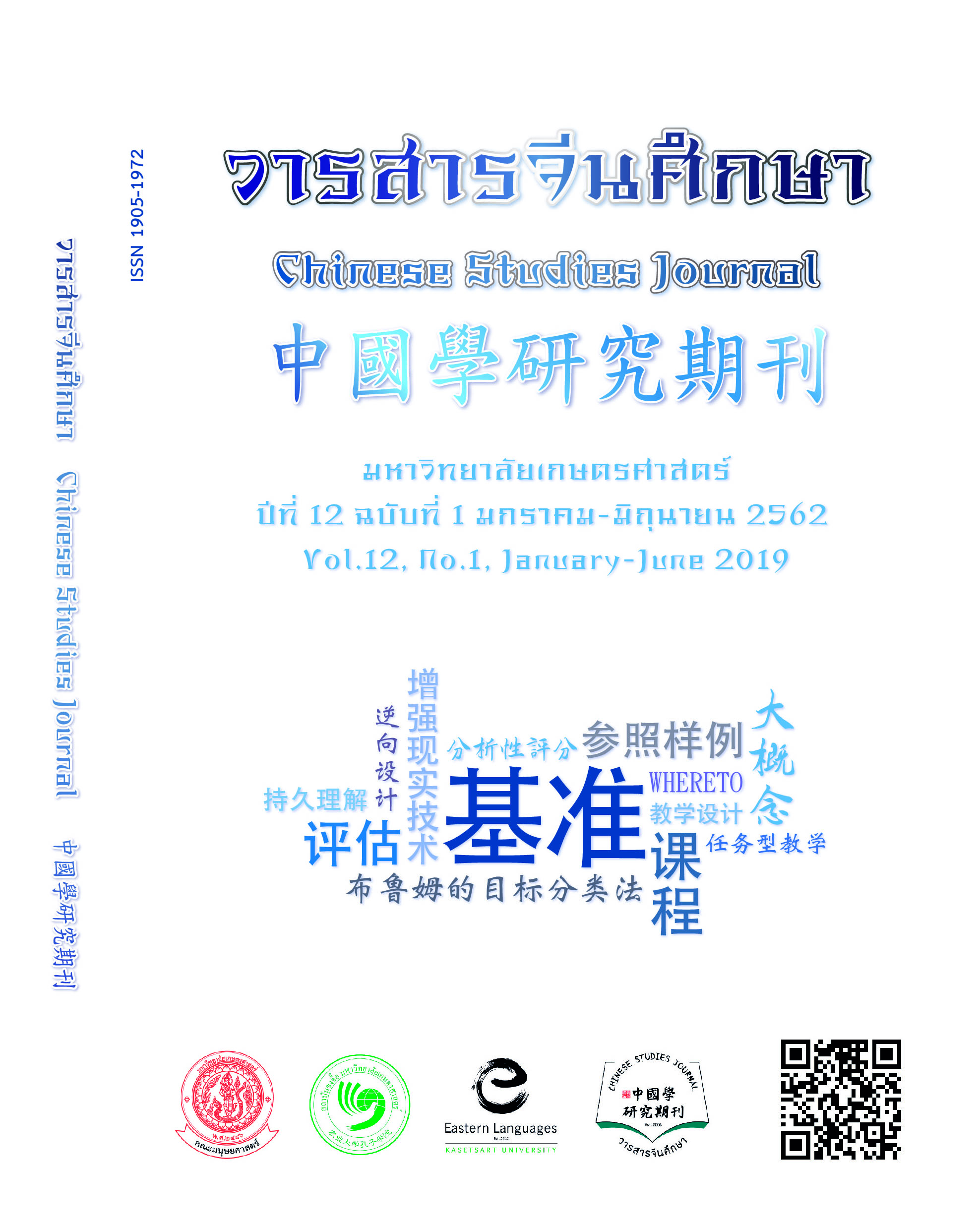The Application of Augmented Reality Technology in Chinese Language Learning A Case Study of the Third Year Foreign Languages Department Students Prince of Songkla University, Surat Thani Campus
Main Article Content
Abstract
Challenges of learning management in the 21st century are the blended learning management as well as the learning by using technology in which learners are able to access unlimited resources. Chinese language is one of the subjects that most of the learners have negative attitudes towards learning. Due to the content difficulty or Chinese letter writing system, most of them lack of interest in learning. The objectives of this research were threefold: 1) to study the application of Augmented Reality Technology in Chinese language Learning 2) to create the teaching guidelines for a new model of Chinese language learning, and 3) to study the students’attitudes towards the new model of Chinese language learning. The questionnaire was used to collect the data from the research samples; 103 third-year students majoring in Languages, Communication and Business in the Faculty of Liberal Arts and Management Sciences, Prince of Songkla University, Surat Thani Campus who enrolled in Chinese for Business Communication course. Additionally, the in-depth interviews were also employed with 30 non-purposive samples in order to gain more data.
The research revealed that 98.1% of students who answered the questionnaire agreed that Augmented Reality Technology was fully useful and suitable for the Chinese language learning and help them in learning various dimensions of Chinese language. Most of them also agreed that this method should be employed in the new model of Chinese language learning classroom, especially for the Chinese specific courses such as Chinese phonetics (Pinyin), vocabulary, and conversation etc. Moreover, most of the students have more positive attitudes towards Chinese language learning.
Article Details
ผลงานทางวิชาการที่ลงตีพิมพ์ในวารสารจีนศึกษา มหาวิทยาลัยเกษตรศาสตร์ เป็นลิขสิทธิ์ของผู้เขียนหรือผู้แปลผลงานนั้น หากนำลงในวารสารจีนศึกษาเป็นครั้งแรก เจ้าของผลงานสามารถนำไปตีพิมพ์ซ้ำในวารสารหรือหนังสืออื่นได้โดยมิต้องแจ้งให้ทราบล่วงหน้า แต่หากผลงานที่ได้รับพิจารณานำลงในวารสารจีนศึกษา เป็นผลงานที่เคยตีพิมพ์ที่อื่นมาก่อนเจ้าของผลงานต้องจัดการเรื่องปัญหาลิขสิทธิ์กับแหล่งพิมพ์แรกเอง หากเกิดปัญหาทางกฎหมาย ถือว่าไม่อยู่ในความรับผิดชอบของวารสารจีนศึกษา มหาวิทยาลัยเกษตรศาสตร์ ทั้งนี้ ความคิดเห็นต่างๆ ในบทความเป็นความคิดเห็นส่วนตัวของผู้เขียน ไม่เกี่ยวกับกองบรรณาธิการวารสารจีนศึกษา มหาวิทยาลัยเกษตรศาสตร์
References
ประยุกต์ใช้เทคโนโลยีความเป็นจริงเสริมกับการศึกษายุค 4.0. วารสารศึกษาศาสตร์
มหาวิทยาลัยนเรศวร. 20(2), 262-278.
ญัฐญา นาคะสันต์และศุภรางค์ เรืองวานิช. (2559). Augmented Reality: เติมชีวิตให้สื่อ
สิ่งพิมพ์ทางการศึกษา. วารสารร่มพฤกษ์ มหาวิทยาลัยเกริก. 34(2), 35-40.
ปถมาภรณ์ ไทยโพธิ์ศรีและพัลลภ พิริยะสุรวงศ์. (2557). การเรียนรู้แบบผสมผสาน ด้วย
เทคโนโลยีความจริงเพิ่มเติม. วารสารศึกษาศาสตร์ มหาวิทยาลัยนเรศวร. 16(3), 215.
ประสาท เนืองเฉลิม. (2556). วิจัยการเรียนการสอน. กรุงเทพฯ : สำนักพิมพ์แห่งจุฬาลงกรณ์
มหาวิทยาลัย.
พิชัย แก้วบุตร. (2562). นโยบายทางภาษาในการเผยเเพร่ภาษาและวัฒนธรรมจีนผ่านการ
ทดสอบวัดระดับภาษาจีน HSK .วารสารวิจัยราชภัฏพระนคร มหาวิทยาลัยราชภัฏพระ
นคร. 14(2). (อยู่ระหว่างการตีพิมพ์)
ศิริรัตน์ เพ็ชร์แสงศรี. (2554). บทความปริทัศน์ การเรียนแบบผสมผสานและการประยุกต์ใช้
Blended Learning and Its Applications. วารสารครุศาสตร์อุตสาหกรรม. 11(1).
Carman, J. M. 2005. “Blended Learning Design: Five Key Ingredients.” [Online]
Retrieved from http://www.agilantlearning.com/ Blended Learning
何克抗.(2009). 21世纪以来教育技术理论与实践的新发展.《现代教育技术
研究所》,2009,10(19).


